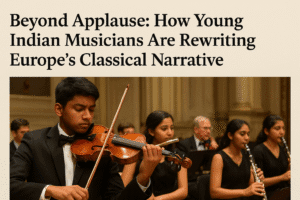Beyond Applause: How Young Indian Musicians Are Rewriting Europe’s Classical Narrative
For five consecutive years, the Indo-European Youth Orchestra (IEYO) has forged an extraordinary cultural bridge. Their landmark 5th Grand Budapest Concert, greeted by a thunderous ovation in Hungary’s Royal Palace of Gödöllő, showcased young Indian musicians mastering Western classics like Beethoven’s Symphony No. 1 – a historic European debut for an India-based orchestra. Led by visionary composer-conductor Michael Rupam Makhal, the ensemble uniquely blended this repertoire with original works like “Spirit of India” and Tagore adaptations, creating a genuine musical dialogue.
Beyond the applause, IEYO’s core mission shines: providing transformative international experience for dedicated Indian students through rigorous preparation, supported by exceptional teachers back home. This sustained success, including annual performances at India’s Embassy in Budapest, proves their model nurtures not just technical skill, but profound intercultural connection. Makhal’s pioneering raga-based compositions, accessible to Western musicians via staff notation, further expand the global orchestral language. IEYO’s remarkable, sustained run in Europe redefines possibilities for young musicians and celebrates the unifying power of shared artistic ambition.

Beyond Applause: How Young Indian Musicians Are Rewriting Europe’s Classical Narrative
The thunderous five-minute ovation that shook the Royal Palace of Gödöllő wasn’t just for the music. It was a European audience embracing a remarkable, sustained cultural dialogue – one meticulously crafted by young Indian musicians and their visionary mentors. The Indo-European Youth Orchestra’s (IEYO) 5th Grand Budapest Concert wasn’t merely a performance; it was a powerful statement of artistic ambition and intercultural fluency.
Breaking Barriers, Note by Note:
For five consecutive years, the IEYO has achieved what many deemed improbable: an orchestra rooted in India, performing Western classical repertoire in the heart of Europe, consistently winning over discerning audiences. This year’s sold-out concert, requiring extra seating in the Hungarian palace, underscored a growing resonance. The audience wasn’t just polite; they demanded encores and rewarded the young ensemble with multiple curtain calls – a testament to the orchestra’s technical prowess and emotional delivery.
The Alchemy of the Concert:
Conducted by the indefatigable Maestro Michael Rupam Makhal, the 27-strong sinfonietta blended rising Indian stars with seasoned Hungarian professionals. The program was a deliberate bridge:
- A Historic Debut: Beethoven’s Symphony No. 1 (1st & 2nd movements) – marking the first performance of this cornerstone work in Europe by an India-based orchestra. This wasn’t imitation; it was claiming a rightful place within the tradition.
- Western Pillars: Masterful renditions of Mozart’s sublime Clarinet Concerto Adagio and Vivaldi’s fiery “Summer” Prezzo, alongside Bach and Shostakovich, demonstrated deep respect and understanding of the European canon.
- The Indian Voice: Maestro Makhal’s original compositions, “Symphony No. 1 – Spirit of India” and “Story of the Stars” (featuring Hungarian flautist Dorottya Takács), seamlessly wove Indian melodic sensibilities and thematic richness into a Western orchestral fabric. Tagore’s timeless “Jodi Tor Dak Shune Keu”, arranged for saxophone and orchestra, provided a poignant cultural anchor.
- Soloist Brilliance: Young Indian soloists like Suraj Subramaniam (violin), Jyotishwar Singh (piano), Aishani Rai Dastidar (clarinet), Hazel Irudayaraj, Atharvan Shankar (saxophone), and Anica D’sa (flute) stood shoulder-to-shoulder with their Hungarian counterparts, showcasing exceptional individual talent nurtured within India’s growing classical infrastructure.
More Than a Stage: The IEYO Ethos
The Budapest concert is the glittering tip of an iceberg built on an unwavering educational mission. Founded by Makhal and cellist/program director Sudeshna Makhal, IEYO consciously eschews the star soloist model. Instead, it focuses on:
- Transformative Opportunity: Providing young Indian music students (many still in their teens) unparalleled international performance experience.
- Rigorous Preparation: The grueling six-hour daily rehearsals in Budapest highlight the immense dedication demanded and fostered.
- Pedagogical Foundation: Acknowledging the crucial role of teachers and institutions across India (like Musikroots, Troika Music School, Art of Violin Hyderabad) in building this talent pipeline.
- Cultural Diplomacy: The pre-concert performance at the Indian Embassy’s Amrita Sher-Gil Cultural Centre solidified their role as active cultural ambassadors.
The Visionary Behind the Bow:
Maestro Makhal is more than a conductor; he’s a pioneer. As one of the few Indian composers with a formal ALCM Diploma in Composition, he creates raga-based orchestral works accessible to Western musicians via staff notation. His compositions like “Spirit of India” aren’t fusion gimmicks; they are serious, structured works expanding the orchestral repertoire itself. His vision empowers both Indian musicians to master Western forms and Western musicians to engage authentically with Indian classical ideas.
Why This Matters Beyond the Music:
The IEYO’s 5th anniversary in Budapest signifies a profound shift:
- Democratizing Access: It proves high-caliber Western classical training and performance opportunities are flourishing beyond traditional Western strongholds.
- Authentic Dialogue: This isn’t superficial cultural exchange; it’s a deep, respectful conversation through shared musical language, enriching both traditions.
- Nurturing the Next Generation: The orchestra is a living incubator, building confidence, discipline, and global perspective in young musicians who will shape the future soundscape.
- Redefining Legacy: They are creating a new model for what a 21st-century orchestra can be: global, inclusive, and educationally driven.
The Resonating Spirit:
The “Spirit of India” echoing in that Hungarian palace wasn’t just the title of a symphony. It was the spirit of dedicated young musicians mastering a complex foreign tradition while proudly contributing their own heritage. It was the spirit of educators investing in potential. It was the spirit of an audience recognizing genuine artistry, regardless of origin. The IEYO’s success story is a compelling reminder that the most beautiful harmonies often arise from the most unexpected collaborations, built on relentless effort and a shared belief in music’s unifying power. Their journey is far from over; it’s a symphony still being written.
You must be logged in to post a comment.